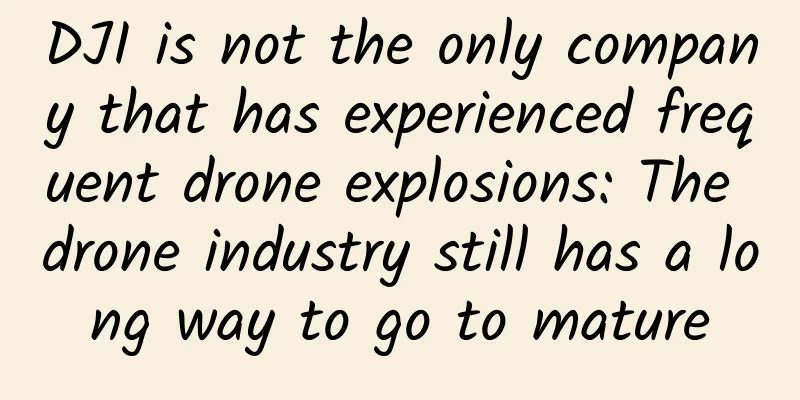DJI is not the only company that has experienced frequent drone explosions: The drone industry still has a long way to go to mature

|
Recently, an article titled "Frequent explosions, DJI drones fall from grace due to broken wings?" has been widely circulated in the industry. The main idea of the article is that DJI's position as the leader in the consumer drone market will be lost due to the frequent "explosions" (crashes) of DJI drones. However, after reading the entire article, apart from screenshots of some user complaints, we did not see any objective data to prove where DJI's frequent "explosions" occurred? What is the specific proportion? What is the real reason for the "explosions"? Since we are talking about drone crashes, let's quote an article published in the Washington Post in June 2014 that detailed the U.S. military drone crashes. The U.S. military report compiled in the article shows that from September 2001 to the end of 2013, there were 418 major crashes of U.S. military drones, of which 194 were Class A accidents and the other 224 were Class B accidents (the U.S. military defines Class A accidents as: complete destruction of the aircraft, or, according to current standards, property damage of at least $2 million. Class B accidents are defined as: accidents that cause losses between $500,000 and $2 million). So the question is, what is the reason for the frequent accidents of military drones, which are far more technologically advanced and reliable than consumer-grade ones? The first is that drones have limited ability to detect and avoid failures. Although drones are equipped with cameras and high-tech sensors, these instruments can never replace the eyes, ears and noses of the pilot sitting in the cockpit. Moreover, most drones are not equipped with radar or collision avoidance systems designed to prevent mid-air disasters. Secondly, the UAV itself has mechanical defects, that is, some UAVs lack safety considerations at the beginning of their design, and are hastily put into actual combat without repeated testing. For example, the most common UAV crashed by the US military is the "Predator" developed by General Atomics Aeronautical Systems. Since the "Predator" is not designed with various backup systems (for example, it only has one engine, one AC generator, and one propeller), if any part of them fails, the aircraft will crash. Once again, there is the issue of communication failure. Drones rely primarily on wireless transmissions for navigation and control, but these technologies are very fragile in practice and are easily interrupted by various forms of interference. Generally, an interruption of a few seconds will not cause any damage. Because once the above situation occurs, the drones will fly in a circular trajectory or hover according to the programming until communication is restored. But in the worst case, they will automatically return to base. But actual records show that this is not the case. In more than a quarter of the most serious drone crashes, communication interruptions or even crashes occurred. Finally, there is the human factor. A US Air Force research report pointed out that the main cause of the crash of the "Predator" drone has shifted from the original hardware failure to human operating errors. In this regard, there is a report that 12 of the 15 "Predator" drone crashes of the US Air Force were caused by human error. In addition, the US Air Force research survey found that 75% of drone crashes were caused by "human factors." It should be pointed out here that military-grade drone operators are professionally trained, and their level should be much higher than that of ordinary consumer-grade drone operators (who have received training), not to mention that most drone users in China have basically not received any training. For example, according to incomplete statistics from the Aircraft Owners and Pilots Association of China (AOPA), there are currently more than 20,000 drones in China, but as of December 31 last year, there were only 2,142 licensed drone operators nationwide, which means that about 90% of drone operators are "unlicensed". Even so, AOPA's data is probably still very conservative, because DJI alone has sold more than 70,000 drones on Tmall since 2013. The above example of US military drones is to illustrate that even military drones, which are much higher in terms of technology, quality, personnel, and other aspects of drone "software and hardware" than consumer drones, still have such a high "crash rate" (mostly caused by human factors). So what about companies like DJI that are positioned in the consumer drone market? We should look at an industry and its manufacturers from the perspective of technology and market reality, and use standards that are close to objectivity. The ultimate test standard is naturally the market and users. According to Skylogic's statistics on the sales of various brands in the North American drone market, two of the top three drone companies in the North American drone market are from China. Among them, DJI has obtained a 50% share and is a veritable sales champion. The second place is the American drone company 3D Robotics, which has a market share of 7%. The third place drone manufacturer is also from China - Yuneec Haoxiang Drone, which has a market share of 4%. According to IDC statistics, Chinese companies occupy most of the global consumer drone market. These include not only DJI, the world's top consumer drone manufacturer, but also Chinese drone companies such as Yuneec, Xiro, and EHang. In the Chinese market, DJI also occupies more than half of the market share. It is worth mentioning that after the last round of financing in May last year, DJI's market value has reached 8 billion US dollars. Although DJI did not disclose its earnings in 2015, it estimates that its sales this year will double to 1 billion US dollars. In fact, these high sales, popularity and profitability are themselves a proof of product quality. As mentioned before, DJI has sold more than 70,000 drones on Tmall alone since 2013. So, based on this data (in fact, DJI’s domestic and global sales far exceed this number), how many “explosions” have occurred at DJI since 2013? Or how many “explosion” complaints have been received? After that, it is necessary to clarify how many factors in the “explosions” are related to DJI’s own products or caused by the operator? Since DJI is said to have frequent “explosions”, even if the number of “explosions” in all years cannot be listed, at least there should be data for some stages, right? It is probably quite unprofessional and imprecise to define “explosions” as frequent based on a few screenshots of user complaints. The industry knows that in response to the rapid growth of drones (mainly consumer drones), the Federal Aviation Administration (FAA) of the United States introduced a series of policies for drone supervision in 2015, including a drone registration system, each drone must be equipped with a professional operator, must obtain a relevant license, and the drone must fly within the operator's line of sight. Specifically in China, first of all, drone operators must have an aircraft pilot license; secondly, the aircraft must have an airworthiness certificate, including an international registration certificate, a test flight certificate, and a radio license; and finally, a flight plan must be declared. Through these policies and regulations, it is not difficult to find that the focus is still on "people", especially operators, especially in China. It can be seen that the biggest safety hazard of drones is still the operator itself. However, from the aforementioned survey of US military drones, drone technology needs to be improved in the future, that is, the drone industry still has a long way to go before it can be truly mature, which also requires drone manufacturers (including DJI), the market, and users, and other parties involved in the drone industry to work together. As a winner of Toutiao's Qingyun Plan and Baijiahao's Bai+ Plan, the 2019 Baidu Digital Author of the Year, the Baijiahao's Most Popular Author in the Technology Field, the 2019 Sogou Technology and Culture Author, and the 2021 Baijiahao Quarterly Influential Creator, he has won many awards, including the 2013 Sohu Best Industry Media Person, the 2015 China New Media Entrepreneurship Competition Beijing Third Place, the 2015 Guangmang Experience Award, the 2015 China New Media Entrepreneurship Competition Finals Third Place, and the 2018 Baidu Dynamic Annual Powerful Celebrity. |
Recommend
How to increase the effectiveness of new media marketing promotion by 3 times?
Recently, I have received a lot of feedback from ...
Is it a person or a person? Who "tampered" with your memory?
Recently, a great debate on memory has been spark...
Intel 100 series motherboard review: a new round of arms race?
The new Skylake platform was officially launched ...
Practice of Android automated page speed measurement in Meituan
background With the rapid development of mobile I...
"I'm the director!" A woman was forced by her parents to take the civil service exam for five years and suffered from schizophrenia. Please don't control your children in the name of love!
Many parents hope that their sons will become suc...
What is the form of Tik Tok advertising promotion? Analysis of the characteristics of the Tik Tok platform!
Tik Tok is a music short video community focusing...
How to play with short video information flow advertising creative sharing
Currently, short video information flow ads are v...
No one likes watching TV anymore? Survey proves smartphones are eating into the TV industry
On December 8, Fortune magazine reported that the...
The team behind Liushen: Unveiling the marketing secrets of viral videos
Speaking of the most popular brand marketing case...
"A person can be infected with COVID-19 up to 8 times"? Experts: There is no basis for this! Symptoms of reinfection are generally mild
"No matter how healthy or strong a person is...
Reusable community operation + live broadcast process!
Due to the impact of the epidemic in 2020, many c...
MyBatis-Plus Tutorial for Silicon Valley 2022
Introduction to the 2022 edition of MyBatis-Plus ...
What are the functions and advantages of developing Wanjiang’s self-service ordering app?
With the development of mobile Internet, many res...
Why were the gravitational waves predicted by Einstein detected only a hundred years later?
The dream of archaeologists is to record the soun...
9032 meters! The second Qinghai-Tibet scientific expedition set a world record for atmospheric science observation by airship
The picture shows the Jimu-1 III airship in front...









